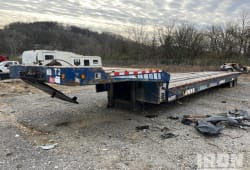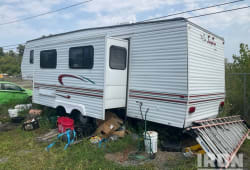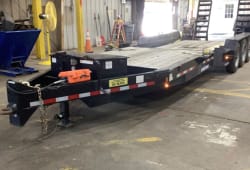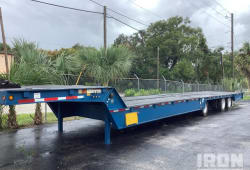Best Lowboy Trailers: A Comprehensive Guide for Heavy Hauling
10 Min read
)
January 27, 2024
When it comes to heavy hauling in the transportation and construction industries, having the right equipment is crucial. Lowboy trailers have emerged as a go-to solution for moving heavy machinery, equipment, and oversized loads. In this comprehensive guide, we will delve into the world of lowboy trailers, exploring their features, benefits, and applications. Whether you are a seasoned professional or a newcomer to the industry, this article will provide you with valuable insights into lowboy trailers and help you make informed decisions for your heavy hauling needs.
What Are Lowboy Trailers?
Lowboy trailers, also known as low-bed or low-loader trailers, are specialized trailers designed for transporting heavy and oversized loads. These trailers are characterized by their low deck height, which allows for the easy loading and unloading of tall and heavy equipment. The low profile of these trailers ensures stability during transportation and minimizes the need for permits when moving oversized loads.
Lowboy trailers are commonly used in industries such as construction, agriculture, mining, and forestry. They are indispensable for hauling heavy machinery like excavators, bulldozers, cranes, and more. The versatility of lowboy trailers makes them an essential asset for any company involved in heavy equipment transport.
Key Features of Lowboy Trailers
Before investing in a lowboy trailer, it's essential to understand their key features. These features play a significant role in determining the trailer's performance and suitability for your specific needs.
Deck Height: The deck height of a lowboy trailer is its most distinctive feature. It is significantly lower than that of conventional trailers, allowing for easy loading and unloading of tall equipment.
Axle Configuration: Lowboy trailers come in various axle configurations, such as two-axle, three-axle, and even more. The choice of axle configuration depends on the weight and dimensions of the loads you intend to transport.
Detachable Gooseneck (RGN): Many lowboy trailers feature a detachable gooseneck, which allows the front section of the trailer to be removed. This feature simplifies the loading process by creating a ramp for equipment to be driven onto the trailer.
Load Capacity: The load capacity of a lowboy trailer can vary widely depending on its design and construction. It's crucial to choose a trailer with the appropriate load rating for your specific hauling needs.
Suspension System: The suspension system of a lowboy trailer plays a critical role in providing stability and ensuring a smooth ride. Air suspension is a popular choice for its adjustability and load-balancing capabilities.
Deck Material: Lowboy trailer decks are typically made of wood, steel, or a combination of both. The choice of deck material affects durability, weight, and maintenance requirements.
Advantages of Using Lowboy Trailers
Using lowboy trailers for heavy hauling offers several advantages:
Versatility: Lowboy trailers can transport a wide range of heavy equipment, making them suitable for various industries and applications.
Load Height: The low deck height of lowboy trailers makes them ideal for carrying tall equipment, reducing the risk of height-related issues during transport.
Maneuverability: Lowboy trailers are known for their excellent maneuverability, allowing for easier navigation through tight spaces and congested job sites.
Weight Distribution: The design of lowboy trailers ensures that the weight is distributed evenly, minimizing the risk of overloading or unbalanced loads.
Compliance: Lowboy trailers often meet regulatory requirements for transporting oversized loads, reducing the need for special permits.
Durability: These trailers are built to withstand the demands of heavy hauling, ensuring a long service life with proper maintenance.
Types of Lowboy Trailers
There are different types of lowboy trailers available, each designed to meet specific hauling needs. Some common types include:
Fixed Gooseneck (FGN): Fixed Gooseneck lowboy trailers have a permanently attached front section. They are simple to operate and suitable for a wide range of loads.
Mechanical Detachable Gooseneck (MDG): Mechanical detachable gooseneck lowboy trailers feature a front section that can be detached and lowered to create a ramp. This design simplifies the loading process.
Hydraulic Detachable Gooseneck (HDG): Hydraulic detachable gooseneck lowboy trailers offer the same advantages as MDG trailers but with hydraulic systems for easier detachment and ramp operation.
Folding Gooseneck (FGN): Folding gooseneck lowboy trailers have a front section that can be folded down to create a ramp. This design is particularly useful for self-loading equipment.
Extendable Lowboy Trailers: Extendable lowboy trailers have telescopic sections that can be extended to accommodate longer loads. They offer flexibility for hauling various equipment sizes.
Considerations When Choosing a Lowboy Trailer
:format(webp))
When selecting a lowboy trailer for your heavy hauling needs, several factors should be taken into account:
Load Capacity: Determine the maximum weight and dimensions of the loads you will be transporting. Ensure the chosen trailer can handle your heaviest equipment.
Axle Configuration: Choose an axle configuration that provides adequate support and weight distribution for your specific loads.
Deck Material: Consider the type of deck material that best suits your requirements, taking into account factors such as weight, durability, and maintenance.
Suspension System: Select a suspension system that offers stability and load-balancing capabilities for a smoother ride.
Detachable Gooseneck: Decide whether a detachable gooseneck is necessary for your loading and unloading processes.
Regulations and Permits: Familiarize yourself with local and federal regulations regarding the transportation of oversized loads, and obtain any necessary permits.
Maintenance and Care of Lowboy Trailers
To ensure the longevity and performance of your lowboy trailer, regular maintenance is essential. Here are some maintenance tips to keep in mind:
Inspect regularly: Conduct thorough inspections of the trailer, including its tires, brakes, lights, and suspension components.
Lubrication: Keep all moving parts well-lubricated to prevent friction and wear.
Cleanliness: Clean the trailer regularly to remove dirt, debris, and corrosive materials that can damage the finish.
Tire Care: Monitor tire pressure and tread wear to prevent blowouts or accidents on the road.
Welding and Repairs: Address any welding or structural issues promptly to maintain the trailer's integrity.
Electrical System: Check the trailer's electrical system for proper functioning, including lights and brakes.
Tips for Safe Operation of Lowboy Trailers
Operating a lowboy trailer safely requires knowledge, skill, and attention to detail. Here are some essential tips to ensure a secure and incident-free transportation process:
Load Securement: Always secure your load properly with appropriate tie-downs, chains, and straps. Ensure that the load is evenly distributed on the trailer to maintain stability during transit.
Pre-Trip Inspection: Conduct a thorough pre-trip inspection of your lowboy trailer before every trip. Check for any signs of wear, damage, or loose components that may compromise safety.
Weight Distribution: Pay careful attention to weight distribution on the trailer to prevent overloading on one side. An imbalanced load can lead to trailer tipping or loss of control.
Slow and Steady: Drive at a safe and controlled speed, especially when hauling heavy loads. Avoid sudden stops, sharp turns, and abrupt maneuvers that can cause accidents.
Communication: If your load obstructs your view or extends significantly beyond the trailer, use appropriate flags, lights, and signage to alert other drivers and ensure visibility.
Adhere to Regulations: Comply with all local and federal regulations regarding oversized load transportation, including obtaining necessary permits and adhering to weight limits and travel restrictions.
Know Your Route: Plan your route, considering factors such as low bridges, narrow roads, and potential obstacles. Familiarize yourself with alternative routes in case unexpected challenges arise.
Weather Conditions: Be cautious when driving in adverse weather conditions. Rain, snow, and ice can affect road traction and handling, making it essential to adjust your driving speed accordingly.
Braking Distance: Recognize that a heavily loaded lowboy trailer will have a longer braking distance. Keep a safe following distance from other vehicles to allow for adequate stopping time.
Emergency Response: Familiarize yourself with emergency procedures in case of mechanical failures, accidents, or other unforeseen incidents on the road. Carry essential safety equipment, such as fire extinguishers and warning triangles.
Lowboy Trailers: Future Innovations
The world of heavy hauling is continually evolving, and lowboy trailers are no exception. Manufacturers are constantly working on innovations to improve efficiency, safety, and sustainability in the transportation industry. Here are some exciting developments on the horizon:
Lightweight Materials: Advancements in materials science are leading to the development of lightweight yet durable materials for lowboy trailer construction. These materials can reduce fuel consumption and increase payload capacity.
Telematics and GPS Integration: Enhanced connectivity through telematics and GPS technology allows for real-time tracking and monitoring of lowboy trailers. This not only improves logistics but also enhances safety and security.
Automation and Self-Loading: Automation technologies are being explored to streamline the loading and unloading process of heavy equipment onto lowboy trailers. This can reduce labor costs and increase efficiency.
Eco-Friendly Designs: As sustainability becomes a priority, manufacturers are exploring eco-friendly options such as electric or hybrid lowboy trailers to reduce emissions and environmental impact.
Improved Suspension Systems: Advanced suspension systems with predictive maintenance capabilities can help prevent breakdowns and ensure a smoother ride for heavy cargo.
Conclusion
Lowboy trailers are the backbone of heavy hauling industries, facilitating the transportation of oversized and heavy equipment to job sites across the world. Their low deck height, versatility, and durability make them essential tools for various sectors, from construction to agriculture, mining to forestry.
When selecting a lowboy trailer, it's crucial to consider factors such as load capacity, axle configuration, deck material, and regulations to ensure that the trailer meets your specific needs and complies with safety standards.
Safety should always be a top priority when operating lowboy trailers. Proper load securement, pre-trip inspections, and adherence to regulations are essential for preventing accidents and ensuring the safety of both the cargo and other road users.
As the transportation industry continues to evolve, we can expect to see exciting innovations in lowboy trailer technology, including lightweight materials, automation, and eco-friendly designs. These advancements will not only improve efficiency but also contribute to a more sustainable and environmentally friendly future.
In conclusion, lowboy trailers are more than just a means of transportation; they are the foundation upon which many industries rely to deliver the heavy machinery and equipment that drive progress and development. With proper knowledge, maintenance, and adherence to safety guidelines, lowboy trailers will continue to play a crucial role in shaping our world.

Mike Kennedy is Boom & Bucket's Marketplace Operations Manager, where he leads shipping, warranties, and post-sale operations to create a seamless buyer experience. As one of the company's earliest team members, Mike helped build the foundation of Boom & Bucket's operations and guided its growth through acquisition by RB Global. He is passionate about scaling marketplaces, solving operational challenges, and improving efficiency to deliver industry-leading results.














